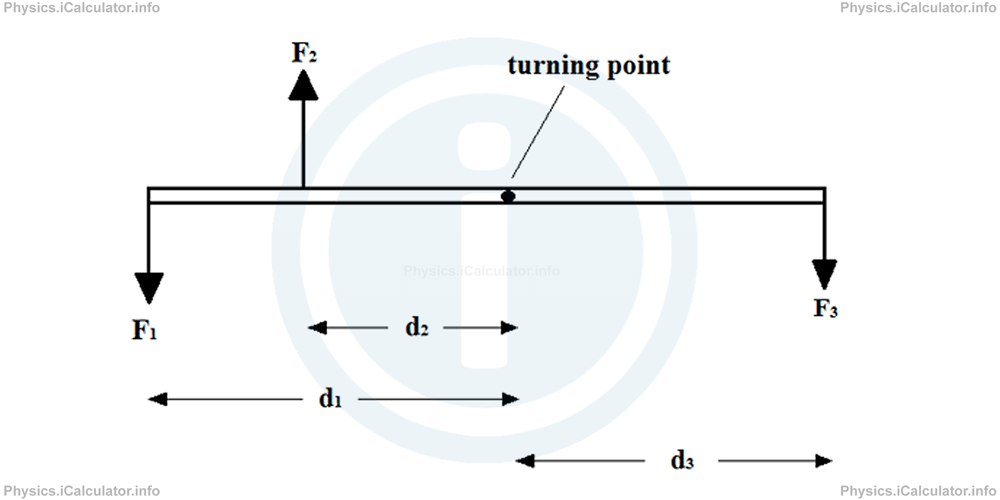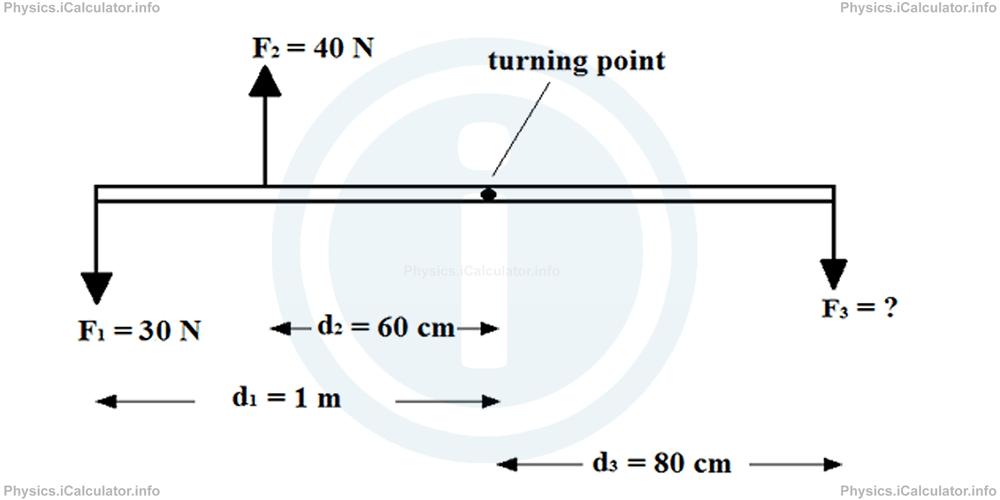Menu
Physics Lesson 6.4.3 - What happens if more than two forces are acting on a turning system?
Please provide a rating, it takes seconds and helps us to keep this resource free for all to use
Welcome to our Physics lesson on What happens if more than two forces are acting on a turning system?, this is the third lesson of our suite of physics lessons covering the topic of Moment of Force. Conditions of Equilibrium, you can find links to the other lessons within this tutorial and access additional physics learning resources below this lesson.
What happens if more than two forces are acting on a turning system?
If there are more than two forces acting on such a system, first we determine the direction of rotation of each force. This is because they may be on the same side of the bar but act in opposite directions as shown in the figure.

From the figure, you can see that F1 causes an anticlockwise turning effect in the system while F2 causes a clockwise effect despite both forces act due right of the turning point. On the other hand, F3 causes a clockwise effect. Therefore, if the system is in equilibrium, we must write (in scalar mode):
instead of
Therefore, we must solely consider the direction of rotation and not the direction in which a force acts in respect to the turning point.
Example 3
Three forces are acting at the system shown in the figure below.

Solution 3
F1 turns the system anticlockwise while F2 and F3 clockwise. Also, d2 = 60 cm = 0.6 m and d3 = 80 cm = 0.8 m.
If there is equilibrium, we have:
Or
All forces are normal to the bar, so, no change is needed on them. Substituting the known values, we obtain
30 = 26 + F3 × 0.8
30-26 = F3 × 0.8
4 = F3 × 0.8
F3 = 4/0.8
F3 = 5N
You have reached the end of Physics lesson 6.4.3 What happens if more than two forces are acting on a turning system?. There are 7 lessons in this physics tutorial covering Moment of Force. Conditions of Equilibrium, you can access all the lessons from this tutorial below.
More Moment of Force. Conditions of Equilibrium Lessons and Learning Resources
Whats next?
Enjoy the "What happens if more than two forces are acting on a turning system?" physics lesson? People who liked the "Moment of Force. Conditions of Equilibrium lesson found the following resources useful:
- Two Forces Turning Feedback. Helps other - Leave a rating for this two forces turning (see below)
- Centre of Mass and Linear Momentum Physics tutorial: Moment of Force. Conditions of Equilibrium. Read the Moment of Force. Conditions of Equilibrium physics tutorial and build your physics knowledge of Centre of Mass and Linear Momentum
- Centre of Mass and Linear Momentum Revision Notes: Moment of Force. Conditions of Equilibrium. Print the notes so you can revise the key points covered in the physics tutorial for Moment of Force. Conditions of Equilibrium
- Centre of Mass and Linear Momentum Practice Questions: Moment of Force. Conditions of Equilibrium. Test and improve your knowledge of Moment of Force. Conditions of Equilibrium with example questins and answers
- Check your calculations for Centre of Mass and Linear Momentum questions with our excellent Centre of Mass and Linear Momentum calculators which contain full equations and calculations clearly displayed line by line. See the Centre of Mass and Linear Momentum Calculators by iCalculator™ below.
- Continuing learning centre of mass and linear momentum - read our next physics tutorial: Linear Momentum
Help others Learning Physics just like you
Please provide a rating, it takes seconds and helps us to keep this resource free for all to use
We hope you found this Physics lesson "Moment of Force. Conditions of Equilibrium" useful. If you did it would be great if you could spare the time to rate this physics lesson (simply click on the number of stars that match your assessment of this physics learning aide) and/or share on social media, this helps us identify popular tutorials and calculators and expand our free learning resources to support our users around the world have free access to expand their knowledge of physics and other disciplines.